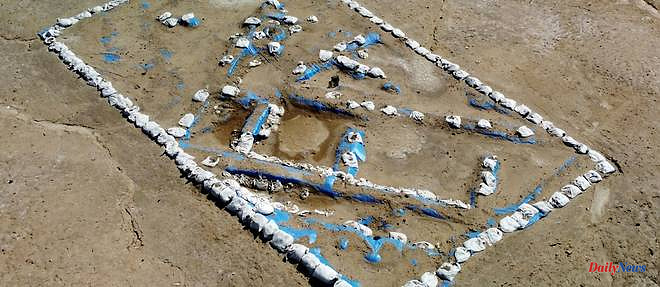A cooling system acting as a refrigerator, bowls containing leftover food, benches: in southern Iraq, land of the "first cities", American and Italian archaeologists have unearthed a Sumerian "tavern" old nearly 5,000 years old.
More than the refined way of life of kings and religious elites, it is the daily life of "ordinary people" that interests archaeologists from the University of Pennsylvania in the United States and their counterparts from the Italian University of Pisa, on Lagash site.
5,000 years ago, the daily life of Lagash was intimately linked to the neighboring city-states of Girsu and Nigin, two religious and political centers of Sumerian civilization which flourished during the period of the archaic dynasties, from 2900 BC. C. to 2334 B.C.
The "tavern" discovered dates back to 2,700 BC, confirms to AFP Holly Pittman, project director of the University of Pennsylvania for the archaeological mission at Lagash.
It evokes a "cooling device" consisting of a jar surrounded by "large stacked broken ceramic containers"... a kind of clay "refrigerator".
There are also cooking utensils, "about 150 bowls" visibly full of food as they contained "fish bones and animal bones", adds Ms Pittman.
But also "tumblers that would have been used for beer", she says, recalling that it was "by far the most common drink for the Sumerians, perhaps even more than water".
This restaurant from ancient times, divided into a covered area and an open space, had benches to sit on and "an oven to cook food", she adds.
-"Ordinary people"-
Iraq is the cradle of the civilizations of Sumer, Akkad, Babylon and Assyria, to which humanity owes writing and the first cities.
Ravaged by decades of conflict, the country suffered from the looting of its antiquities, after the American invasion of 2003, then with the arrival of jihadists from the Islamic State group.
But by returning to a semblance of normality in recent years and despite decaying infrastructure, the country has timidly opened up to world tourism and archaeological missions from the United States or Europe have resumed service, with new discoveries. regularly announced.
In Lagash, archaeologists are still trying to determine the interweaving of the city with its surroundings, in particular the relationship with Girsu, where a temple honored Ningirsu, Sumerian divinity of spring, stormy rains, but also of the plow and plowing.
"Lagash was an important city in southern Iraq," says Iraqi archaeologist Baker Azab Wali, who collaborated with his Western colleagues on the Lagash site.
"Its inhabitants depended on agriculture, livestock, fishing, but also on the exchange of goods," he adds.
Holly Pittman mentions several ceramic workshops with kilns that suggest that Lagash was "an important center for mass craft production".
"The first cities appeared in southern Mesopotamia," she recalls. "There is so much we don't know about this period of the emergence of cities."
Discovered in the fall of 2022, the tavern will bring "new knowledge", she says.
“We hope to be able to determine the characteristics of the neighborhoods, the type of occupation and the identifying markers of the people who lived in this big city and who were not part of the elite”, she adds.
"Most of the work done on the other sites focuses on kings and priests, and that's very important," she points out. "But ordinary people are also important."
02/15/2023 11:39:54 - Lagash (Iraq) (AFP) - © 2023 AFP












